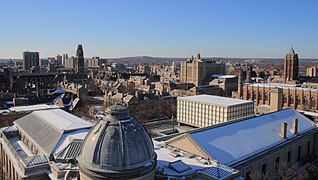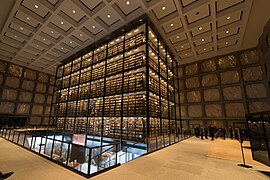
Beinecke Rare Book & Manuscript Library
The Beinecke Rare Book & Manuscript Library (/ˈbaɪnɪki/) is the rare book library and literary archive of the Yale University Library in New Haven, Connecticut. It is one of the largest buildings in the world dedicated to rare books and manuscripts and is one of the largest collections of such texts.[1] Established by a gift of the Beinecke family and given its own financial endowment, the library is financially independent from the university and is co-governed by the University Library and Yale Corporation.[2]
Beinecke Rare Book & Manuscript Library
1963
Rare books and manuscripts
Situated on Yale University's Hewitt Quadrangle, the building was designed by Gordon Bunshaft of Skidmore, Owings & Merrill and completed in 1963.[3][4] From 2015 to 2016 the library building was closed for 18 months for major renovations, which included replacing the building's HVAC system and expanding teaching and exhibition capabilities.[5]
The Beinecke Library is an International Style building. Its six-story above-ground glass-enclosed tower of book stacks is encased by a windowless façade, supported by four monolithic piers at the corners of the building. The exterior shell is structurally supported by a steel frame with pylons embedded 50 feet (15 m) to bedrock at each corner pier, and the façade is constructed of translucent veined marble and granite. The marble was quarried from Danby, Vermont, and milled to a thickness of 1.25 inches (32 mm) in order to allow filtered daylight to permeate the interior in a subtle golden amber glow. Gordon Bunshaft attributed the inspiration for this effect to "what I thought was onyx in a Renaissance-type palace in Istanbul,"[6] referring to the alabaster used in the Dolmabahçe Palace hammam.[7]
These panels are framed by a hexagonal grid of Vermont Woodbury granite veneer, fastened to a structural steel frame. The outside dimensions have Platonic mathematical proportions of 1:2:3 (height: width: length).[8] The building has been called a "jewel box",[9][10] "treasure casket" (by Bunshaft himself),[6] and a "laboratory for the humanities".[2] It contains furniture designed by Florence Knoll and Marcel Breuer.[11]
An elevated public exhibition mezzanine surrounds the glass stack tower, and displays among other things, one of the 48 extant copies of the Gutenberg Bible.[10] Two basement floors extend under much of Hewitt Quadrangle. The first sub-grade level, the "Court" level, centers on a sunken courtyard in front of the Beinecke, which features The Garden (Pyramid, Sun, and Cube). These are abstract allegorical sculptures by Isamu Noguchi that are said to represent time (the pyramid), sun (the disc), and chance (the cube).[12] This level also features a secure reading room for visiting researchers, administrative offices, and book storage areas. The level of the building two floors below ground has movable-aisle high-density shelving for books and archives.[13]
The Beinecke is one of the larger buildings in America devoted entirely to rare books and manuscripts.[1] The library has room in the central tower for 180,000 volumes and room for over 1 million volumes in the underground book stacks.[1] The library's collection, which is housed both in the library's main building and at Yale University's Library Shelving Facility in Hamden, Connecticut, totals roughly 1 million volumes and several million manuscripts.[1]
During the 1960s, the Claes Oldenburg sculpture Lipstick (Ascending) on Caterpillar Tracks was displayed in Hewitt Quadrangle. The sculpture has since been moved to the courtyard of Morse College, one of the university's residential dormitories.
The design of the Beinecke Library later inspired the glass-walled structure that protects and displays the original core collection (the books given by King George III and referred to as the King's Library) within the British Library building in Euston, London.[14]
Security[edit]
The Beinecke collection does not circulate; all materials are to be consulted in the reading room. The library hosts almost 10,000 research visits annually, almost half of which are with scholars having no formal affiliation to Yale University.[1]
Security measures were significantly increased after the well-known antiques dealer Edward Forbes Smiley III was caught cutting maps from rare books with an X-acto blade in 2005. Smiley's scheme was discovered when he dropped his concealed tool in the reading room, and he subsequently served several years in prison for thefts of rare documents valued in millions of dollars from the Beinecke and other libraries.[24] The library operates under a closed stack system, and rigorous security rules now allow carefully controlled access to materials under video surveillance.[25]
The glass-enclosed central stacks (not accessible to the public) can be flooded with a mix of Halon 1301 and Inergen fire suppressant gas if fire detectors are triggered.[26] A previous system using carbon dioxide was removed for personnel safety reasons.[27]
After an infestation of the death watch beetle was discovered in 1977, the Beinecke Library helped pioneer the non-toxic method of controlling paper-eating pests by freezing books and documents at −33 °F (−36 °C) for three days. All new acquisitions are given this treatment as a precaution, and the deep freeze method is now widely accepted for pest control in special collections libraries.[13][26][28]



